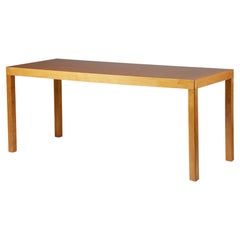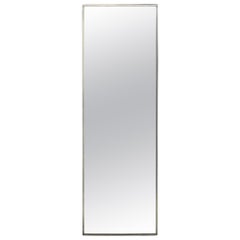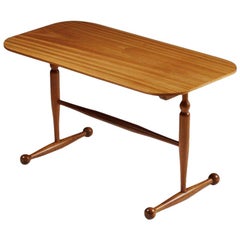Want more images or videos?
Request additional images or videos from the seller
1 of 9
Armchair, designed by Uno Åhrén or Björn Trägårdh for Svenskt Tenn, Sweden 1930s
$20,378.76List Price
About the Item
- Creator:Uno Åhrén (Designer)
- Dimensions:Height: 43.31 in (110 cm)Width: 24.81 in (63 cm)Depth: 27.56 in (70 cm)Seat Height: 16.15 in (41 cm)
- Style:Scandinavian Modern (Of the Period)
- Materials and Techniques:
- Place of Origin:
- Period:
- Date of Manufacture:1930s
- Condition:
- Seller Location:Stockholm, SE
- Reference Number:1stDibs: LU1006618481432
About the Seller
5.0
Recognized Seller
These prestigious sellers are industry leaders and represent the highest echelon for item quality and design.
Gold Seller
Premium sellers maintaining a 4.3+ rating and 24-hour response times
Established in 1998
1stDibs seller since 2013
206 sales on 1stDibs
Typical response time: 4 hours
Authenticity Guarantee
In the unlikely event there’s an issue with an item’s authenticity, contact us within 1 year for a full refund. DetailsMoney-Back Guarantee
If your item is not as described, is damaged in transit, or does not arrive, contact us within 7 days for a full refund. Details24-Hour Cancellation
You have a 24-hour grace period in which to reconsider your purchase, with no questions asked.Vetted Professional Sellers
Our world-class sellers must adhere to strict standards for service and quality, maintaining the integrity of our listings.Price-Match Guarantee
If you find that a seller listed the same item for a lower price elsewhere, we’ll match it.Trusted Global Delivery
Our best-in-class carrier network provides specialized shipping options worldwide, including custom delivery.You May Also Like
Bjorn Tragardh and Uno Åhren, Lounge Chair, Velvet, Birch, Sweden, 1930s
By Bjorn Tragardh, Svenskt Tenn
Located in High Point, NC
A modernist velvet and birch lounge chair designed by Bjorn Tragardh and Uno Åhren and produced by Svenskt Tenn, Sweden, 1930s.
Seat Height (inches): 15.5"
Arm Height (inches): 23....
Category
Vintage 1930s Swedish Scandinavian Modern Lounge Chairs
Materials
Velvet, Birch
$13,900
H 43.31 in W 24.81 in D 27.96 in
Armchair by Uno Åhrén
By Svenskt Tenn
Located in Borås, SE
Armchair by Uno Åhrén
ca. 1930s
Mohair velvet, stained wood feet.
Designed ca. 1930 by Uno Åhrén. Produced by Firma Svenskt Tenn.
Uno Åhrén (1897...
Category
Vintage 1930s Swedish Scandinavian Modern Armchairs
Materials
Upholstery, Wood
Easy Chairs Attributed to Uno Åhrén or Björn Trädgårdh by Svenskt Tenn in Sweden
Located in Limhamn, Skåne län
Rare pair of easy chairs attributed to Uno Åhrén or Björn Trädgårdh. Produced by Svenskt Tenn in Sweden.
Category
Vintage 1930s Swedish Scandinavian Modern Lounge Chairs
Materials
Fabric, Oak
$14,984 / set
H 41.34 in W 24.81 in D 30.71 in
Pair of Swedish Folding Chairs by Uno Åhrén for Gemla, 1930s
By Gemla
Located in Vienna, AT
Pair of folding chairs designed by Uno Åhrén in the 1930s for Gemla. Beechwood with black iron back legs..
Used condition
Category
Vintage 1930s Swedish Bauhaus Chairs
Materials
Leather, Beech
$1,190 / set
H 33.08 in W 17.33 in D 19.3 in
Swedish Modern Armchairs, 1930s
By Axel Einar Hjorth
Located in Stockholm, SE
Rare pair of early 1930s Swedish pine armchairs.
These chairs combine sculptural presence with refined materials — solid pine frames with rich grain and original olive-green velvet u...
Category
Vintage 1930s Swedish Scandinavian Modern Armchairs
Materials
Pine
“Oskar” Armchair by Carl Malmsten for O.H. Sjögren, Sweden 1930s
By Carl Malmsten, O.H. Sjögren
Located in Utrecht, NL
The ‘Oskar’ armchair was designed in 1939, the same year that Carl Malmsten participated in the New York World’s Fair. It was there that the expression “Swedish Modern” was coined, b...
Category
Vintage 1930s Swedish Scandinavian Modern Armchairs
Materials
Fabric, Wood
$6,600
H 37.41 in W 28.75 in D 29.93 in
Swedish Designer, Armchairs, Birch, Velvet, Sweden, 1930s
Located in High Point, NC
A pair of dark-stained wood and green velvet armchairs designed and produced in Sweden, c. 1930s.
Dimensions: 36” H x 24” W x 23” D
Seat Height: 18.75”
All upholstered furniture c...
Category
Vintage 1930s Swedish Scandinavian Modern Armchairs
Materials
Velvet, Birch
Pair of 1930s green Björn Trägårdh Lounge Chairs with ornaments, Sweden
By Bjorn Tragardh
Located in Berlin, DE
Björn Trägårdh lounge chairs in original condition, Sweden - 1930s.
Category
Vintage 1930s Swedish Lounge Chairs
Materials
Fabric, Upholstery
Price Upon Request
H 27.56 in W 25.99 in D 32.68 in
Scandinavian Modern Armchairs by Elias Svedberg, Sweden, 1930s
By Elias Svedberg
Located in Stockholm, SE
Pair of elegant armchairs by Elias Svedberg, made from birch with flowing lines and an open silhouette. Upholstered with supple brown leather.
Category
Vintage 1930s Scandinavian Modern Armchairs
Materials
Leather, Birch
$8,810 / set
H 28.75 in W 22.45 in D 22.05 in
20th Century Swedish Vintage Svenskt Tenn Pair of Beech Armchairs by Josef Frank
By Svenskt Tenn, Josef Frank
Located in West Palm Beach, FL
A vintage Swedish Art Deco pair of armchairs made of hand crafted polished Beechwood, designed by Josef Frank for Svenskt Tenn in good condition. The set of two Scandinavian dining room chairs have a slightly reclined backrest which is enhanced by a rattan pattern. The slim arched armrests are partly upholstered and the seat cushions are particularized by bonze nailheads. The chairs are standing on four wooden legs. Model Nr. 969. Newly upholstered in a white-grey cotton velour. Wear consistent with age and use. Dated 1939, Stockholm, Sweden, Scandinavia.
Seat: 19" H x 21.5" W x 19" D
Josef Frank was born in 1885, in Baden, Austria and passed away in 1967, in Stockholm, Sweden. He was an architect, artist, and designer. Frank studied architecture at the Vienna University of Technology and was a founding member of the Vienna Werkbund. Frank was considered one of the most prestigious designers in the Stockholm design company Svenskt Tenn.
Svenskt Tenn is a Swedish interior design store founded in 1924, in Stockholm, Sweden by a Swedish teacher and pewter artist Estrid Ericson. In the early time, Svenskt Tenn was appointed as a royal warrant. Later on, Ericson and the pewter artist Nils Fougstedt produced modern pewter objects. In 1925, the Svenskt Tenn won a Gold Medal at the 1925 Exposition...
Category
Early 20th Century Swedish Art Deco Armchairs
Materials
Fabric, Cotton, Upholstery, Beech
$19,900 / set
H 32 in W 27 in D 23 in
More From This Seller
View AllLibrary Table Designed by Uno Åhrén for Svenskt Tenn, Sweden, 1930
Located in Stockholm, SE
Library table designed by Uno Åhrén for Svenskt Tenn,
Sweden, 1930.
Elm.
Early maker's mark underneath the surface.
H: 75 cm
L: 180 cm
W: 70 cm.
Category
Vintage 1930s Swedish Mid-Century Modern Dining Room Tables
Materials
Elm
1930 Mirror by Björn Trägårdh for Svenskt Tenn – Swedish Modernist Brass-Framed
By Bjorn Tragardh
Located in Stockholm, SE
Mirror, anonymous,
Sweden, 1930s.
Pewter and mirrored glass.
Measurements:
H: 161 cm/ 5' 3 1/2"
W: 55 cm/ 21 3/4"
Category
Vintage 1930s Swedish Scandinavian Modern Wall Mirrors
Materials
Pewter
Mirror Designed by Estrid Ericson for Svenskt Tenn, Sweden, 1930
By Estrid Ericson
Located in Stockholm, SE
Mirror designed by Estrid Ericson for Svenskt Tenn,
Sweden, 1930.
Pewter and mirror.
Measures: H: 62.5 cm / 2' 1/2''
W: 41 cm / 16''
D: 2 cm / 3/4''.
Category
Mid-20th Century Swedish Mid-Century Modern Mirrors
Materials
Pewter
Occasional Table Designed by Josef Frank for Svenskt Tenn, Sweden, 1950s
By Josef Frank
Located in Stockholm, SE
Occasional table designed by Josef Frank for Svenskt Tenn,
Sweden. 1950s.
Mahogany.
H: 45 cm
L: 80 cm
D: 40 cm
Josef Frank was a true European, he was also a pioneer of what would become classic 20th century Swedish design and the “Scandinavian Design Style”.
Austrian- born Frank started his design career as an architect after having trained at the Technische Hochschule in Vienna between 1903 and 1910. After his training he went on to teach at Kunstgewerbeschule (The Viennese School of Arts and crafts) where he developed and espoused the new school of modernist thinking towards Architecture and Design that was coming to fruition in Vienna at the time. He also went on to lead the Vienna Werkbund throughout the 1920s. This was a truly progressive group of Architects and Designers who set about improving the daily lives of Austrian people through modernist design and architecture in partnership with Arts and Crafts ideals and construction. Frank’s leadership of the Werkbund had already cemented his place at the forefront of European design.
Frank’s time in Vienna was typified by his design for the “Die Wohnung” exhibition of the Deutscher Werkbund in Stuttgart, 1927 where he exhibited along side his contemporaries at the forefront of design, such as the likes of Le Corbusier and Walter Gropius. Here he showed a specially designed pair of flat-roofed reinforced concrete houses in what is now seen as a typical modernist style.
What separated Frank’s house from the other 32 houses of the exhibition was the interior and furniture inside the building. It was described as “Neo-Classical” and filled with an eclectic mix of period pieces, modern design and pieces designed by Frank himself that seemed to cross the two worlds. This was a complete opposite direction to that which his fellow Architects were travelling in with their pared back and angular aesthetics. Frank said of his own work: “The house is not a work of art, simply a place where one lives,” and by this reasoning Frank rejected the regimental mechanisation of the living space that his contemporaries believed in, instead he set about creating congenial and spontaneous interiors. Frank’s practice saw him placing the bright colours and the soft forms of nature back into the furnishings and interiors that he thought modernism sorely mist.
Frank, along with Oskar Walch set up Haus und Garten in Vienna in 1925. This was Frank’s first commercial foray into furniture and home furnishings and the company went on to become the most influential furnishing house in Vienna with a riotous depth of colour and interesting shapes becoming the trademark of their design. However this success was to come to an end with rise of Nazism in Vienna in the early 1930’s. Frank was Jewish, and he and his wife Anna decided they would leave Vienna for her motherland: Sweden, in 1933. Frank continued to design for Haus and Garten, visiting Vienna occasionally and designing the pieces that would continue to be the company’s best...
Category
Vintage 1950s Swedish Scandinavian Modern Tables
Materials
Mahogany
Occasional Table Designed by Josef Frank for Svenskt Tenn, Sweden, 1950s
By Josef Frank
Located in Stockholm, SE
Occasional table designed by Josef Frank for Svenskt Tenn,
Sweden, 1950s.
Mahogany.
Measurements:
H: 60 cm/ 23 1/2''
Length when extened: 104 cm/ 3' 5''
D: 54 cm/ 21 1/2''
Jose...
Category
Vintage 1950s Swedish Scandinavian Modern Side Tables
Materials
Mahogany
Pewter Jar with Lid Designed by Estrid Ericson for Svenskt Tenn, Sweden, 1930
By Estrid Ericson
Located in Stockholm, SE
Pewter jar with lid designed by Estrid Ericson for Svenskt Tenn,
Sweden, 1930.
Pewter.
Stamped.
H: 21.5 cm / 8 1/2''
D: 15 cm / 6''
Provenance: Actor Anders de Wahl (18...
Category
Mid-20th Century Swedish Mid-Century Modern Jars
Materials
Pewter



